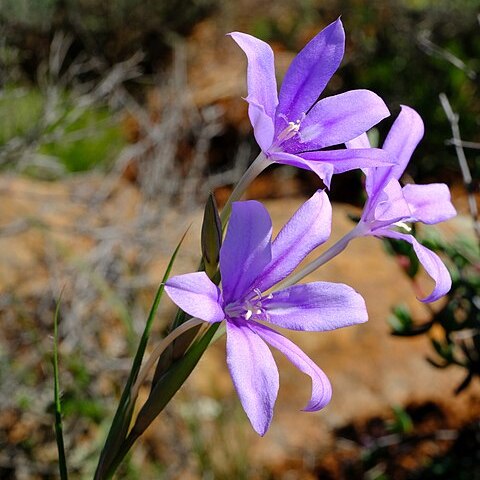Plants 100-200(-300) mm high, including leaves, often in small clumps. Corm with fibrous tunics. Stem subterranean or reaching above ground when growing through vegetation, producing slender cormlets in lower axils, simple or 1-branched, enclosed below by collar of brittle fibres. Leaves linear, exceeding flowers, up to 200 x 2-5(-8) mm, flat, sparsely pubescent. Spike 2-or 3-flowered; bracts green, becoming dry and brown at tips, 30-35 mm long, finely hairy, long-attenuate, inner slightly shorter than outer, 2-keeled, forked apically. Flowers actinomorphic, salver-shaped, tepals spreading when fully open, violet with darker violet marks near tepals bases, sometimes lower lateral tepals marked white outlined violet, sweetly scented of violets; perianth tube cylindric, 45-60(-75) mm long, straight, slightly expanded in upper 10 mm, hollow above but with thick walls tightly enclosing style in lower half; tepals subequal, lanceolate, (22-)28-35 x 5-7 mm, inner tepals narrower than outer. Stamens symmetrically arranged, erect; filaments ± 10 mm long, exserted ± 7 mm, purple; anthers ± 6 mm long, contiguous at tips, white; pollen white. Ovary smooth; style erect, purple, dividing below base of anthers, branches 4-5 mm long, expanded in upper 1/3, arching between anthers.
More
Cormous geophyte, 120-200 mm tall, stem mainly subterranean, 1-or 2-branched. Leaves linear, sparsely long-hairy, margins plane. Flowers 3-5 in a short spike, radially symmetric, blue-violet with white nectar guides outlined purple, sweetly scented, perianth tube 45-75 mm long, tepals subequal, dorsal ± 37 x 6 mm, ovary smooth, bracts shortly hairy on veins, inner forked apically.

